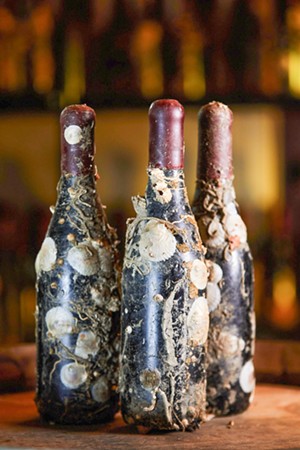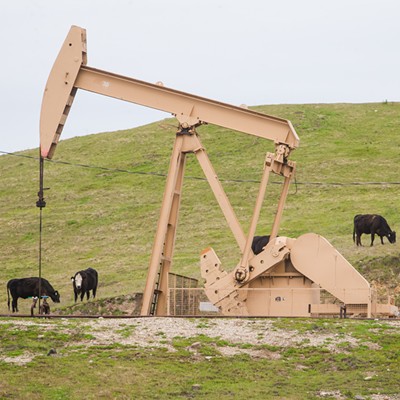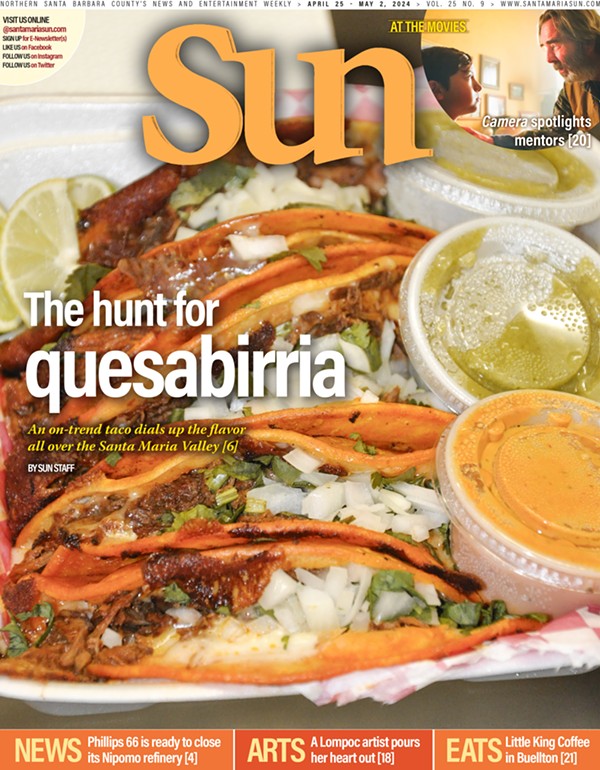Emanuele Azzaretto believes the seafloor is the best spot on Earth to store wine.
He’s one of the co-founders of Ocean Fathoms, a Santa Barbara County based company that developed a process to store wine bottles at the bottom of the ocean. The consistent cold temperatures and dark waters make an ideal environment for the bottled libation, and the natural rhythms of the ocean give it a distinct taste, Azzaretto said. Encrusted with sand dollars and other sea life, no two bottles are alike once they come up to the surface.

But Ocean Fathoms’ perfect wine storage system has a problem: After operating off the Montecito coast without a permit, the California Coastal Commission ordered Ocean Fathoms to remove its submerged wine cages from the ocean floor earlier this year. Now Coastal Commission staff is recommending a denial of the company’s application for an after-the-fact permit. While Azzaretto says his proprietary system is a “very green product,” some environmental advocates say otherwise.
An underwater venture
According to a staff report from the Coastal Commission, Ocean Fathoms first started testing the technique in 2016, and in 2019 put a steel wine storage cage a little less than a mile off the coast of Montecito where it stayed for a year. The report states that this cage was recovered in March 2020, and replaced with two more for another year-long submersion.
Azzaretto said he wanted to obtain the right permits when he first started operating, but didn’t know which agency to go to or what permit was the right one.
“We were asking, nobody knew what permits we should fall under, so it’s been a long process to figure out,” Azzaretto said. “When I started I went to the Coast Guard and said, ‘I’m putting a box down, do I need to pull a permit? How should I operate?’”
Azzaretto said he contacted the U.S. Army Corps of Engineers, the Coastal Commission, and the state to try to apply for a permit. According to the Coastal Commission’s staff report, the Army Corps learned about the activities first in July 2020, when the wine was already on the seafloor.
“At the time that we received the application, what we found out after was that the development that they applied for had actually been installed without a permit,” the commission’s Deputy Director of Energy Ocean Resource and Federal Consistency Kate Huckelbridge said. “That was the first we had heard of it.”
Huckelbridge acknowledged that “it’s a new industry, and it’s possible they didn’t understand the full range of the authorizations required.” But even so, from her perspective, one thing is clear: You can’t operate an ocean development without a permit.
“There should be no confusion,” she said. “There’s only one permitting option for any development within the ocean, and it’s the coastal development permit.”
Furthermore, Huckelbridge said, even if Ocean Fathoms had applied for a permit prior to dropping its wine cages down, the Coastal Commission staff probably wouldn’t have recommended approval.
“In staff’s view, it’s clearly not allowable under the Coastal Act to install this kind of development,” she said. “There is a list of things that are allowable. It’s a pretty clear case of this not being consistent with the Coastal Act.”
Azzaretto says his company never tried to hide its operations and didn’t know it was doing anything wrong. He added that he didn’t know he needed a development permit because he sees it “more as something that’s going in and going out and is not permanent.”
“In the sense that, until somebody said that we were doing something non-correct, we believed to be doing everything as properly required,” he continued. “I don’t think we’re doing anything bad or wrong to anybody. I think they should be proud that we’re doing a very green product. All we’re doing is using the ocean to manipulate wine without really interfering with anybody.”
Environmental dispute
An octopus clings to the side of the bottle in one image of a wine bottle Ocean Fathoms retrieved from the sea. Todd Hahn, a co-founder of the company, noted in an email that “the octopus was delivered back into its ocean home immediately after the picture was taken.”
But Huckelbridge is concerned about the disruption to sea life happening while the crates sit on the seafloor.
“It’s taking up ocean floor habitat,” she said. “So where those wine crates are, there’s creatures that live there and they’re being crushed, and it is disruptive to the existing habitat. Ocean life attaches itself. That marine wildlife is being removed.”
Susan Jordan, executive director of the California Coastal Protection Network, said some of the marine life that attaches to the bottles can’t be returned to their homes.
“You’re not supposed to disturb creatures like that,” Jordan said. “When you go out to tide pools, you’re not supposed to remove the animals. You’re supposed to observe them.”
Wine benefits
Alfredo Koch, viticulture and enology program coordinator at Allan Hancock College, said the practice of putting wine on the ocean floor isn’t just a novelty—it truly is a perfect environment. He said that winemakers in Italy and Greece have already experimented with seafloor storage.
“Any changes in temperature will make an impact on the wine because the temperature will change the pressure inside the bottle,” Koch said. “So this expands and contracts according to different temperatures and that creates different pressures.”
The consistently cold water is particularly ideal.
“If you have a bottle exposed to sudden change in temperature, it changes the oxygenation so it ages much faster,” he said. “That’s why you don’t want to expose the wine to the heat.”
Koch added that the ocean currents would gently churn the wine in the bottles in a way that’s hard to come by on land.
“That could create some interesting absorption,” he said. “Depending on the varietal, it might increase the body of the wine. Without movement this would not happen.”
But, despite the benefits to the wine, Koch was also wary of the environmental impacts it could have. After the oil spills that the Santa Barbara County coastline has experienced, he said, local marine life doesn’t need any more disruptions.
“I wouldn’t promote anything that would create any damage to the ecological environment,” Koch said.
What’s next
With the staff recommendation to deny the after-the-fact permit, the Coastal Commission plans to take up the issue for a vote in August. If the commission votes in line with staff’s recommendation to deny the permit, Ocean Fathoms isn’t going to give up. Azzaretto said his company would consider taking its operations 3 miles out from the shore, where the state waters boundary meets federal waters.
Huckelbridge said in this case, the operation would still have to get federal consistency certification. It’s hard to know now whether this would be granted, she said, and it would still have to come before the Coastal Commission.
The Santa Ynez Band of Chumash Indians and 1st District Supervisor Das Williams both signed letters to the Coastal Commission voicing support for Ocean Fathoms’ wine aging method.
“This project, other than the unique style of making wine, is innovative,” both letters state. “We live in a county that is full of wine ventures but we have not seen anything like this. Allowing this business would further our county, coast, and state’s reputation as a premier wine location in the world. With your support their business would also bring higher paying jobs to our local economy.”
Williams told the Sun that he believes it’s important to put Ocean Fathoms’ proposed operations in context. The cages have a relatively small footprint, about 4 by 4 feet sitting on the ocean floor, and Williams said they’re sitting in sand.
“If he was proposing to sink it out on a reef, I would be virulently opposed,” Williams said. “That’s not what they’re proposing.”
The Coastal Commission staff and environmental advocates beg to differ, which is why the commission ordered Ocean Fathoms to remove its wine cages earlier this year, and it did. Whether the company can obtain the after-the-fact permit is now in the hands of the Coastal Commission.
“We’re trying to comply with everybody,” Azzaretto said.
Reach Staff Writer Malea Martin at [email protected].















